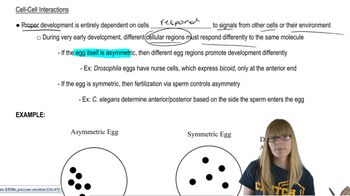Here are the essential concepts you must grasp in order to answer the question correctly.
Somatic Cells
Somatic cells are any cells in a multicellular organism that are not germ cells (sperm or egg). They make up the majority of an organism's body and undergo mitosis for growth and repair. Mutations in somatic cells can occur without affecting the organism's overall phenotype, especially if they happen in non-coding regions of DNA or in cells that do not contribute to the organism's visible traits.
Recommended video:
Mutation Types
Mutations can be classified into several types, including silent, missense, and nonsense mutations. Silent mutations do not change the amino acid sequence of a protein, while missense mutations may alter a single amino acid, and nonsense mutations create a premature stop codon. A mutation in a somatic cell may not lead to a detectable phenotype if it is silent or occurs in a non-essential gene.
Recommended video:
Phenotype Expression
Phenotype refers to the observable characteristics of an organism, which result from the interaction of its genotype with the environment. Not all genetic changes lead to visible traits; some may be compensated for by other genes or may not affect the organism's function. Therefore, a mutation in a somatic cell may not manifest as a detectable phenotype if it does not influence the organism's overall appearance or health.
Recommended video:
Penetrance and Expressivity






